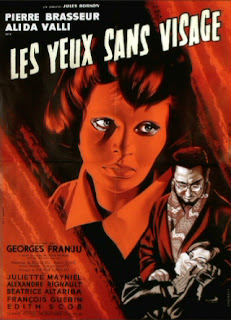This was something else. I mean, I enjoyed the other AFS screenings, but this movie is on an entirely different level. Since I have never seen it before, it was nice to get a chance to see it on the big screen.
"This time I must try removing a larger section. In one piece..."
Riding the line between surrealism and documentary-like realism, Georges Franju's Eyes Without a Face is regarded as a unique masterpiece within the pantheon of classic horror cinema. And I can see why.
The first thing to say about this movie is that it is just beautiful to look at. Shot in glistening monochrome by Eugen Schufftan, the brilliant cinematographer behind Fritz Lang's Metropolis, the photography is sharp and clear, with atmospheric location footage (especially during the night scenes). The musical score is one of the first major works by future Oscar winner Maurice Jarre, and it is... interesting. He gives every major character a specific theme, which is normal practice, but what makes his work here interesting is that each of these themes feel like they come from completely different movies, and yet somehow this disjunction works with the film's off-kilter sensibility.
The film was written by the team of Boileau-Narcejac, novelists who today are more well known for the films based off their thrillers, the twisted, bleak Les Diaboliques directed by Henri-Georges Clouzot and Alfred Hitchcock's equally brilliant Vertigo. With their shared theme of men attempting to control the minds and bodies of women, these films share more than a little DNA with Eyes without a Face.
While it does not really have traditional scares, the film has a weird, unsettling atmosphere that is unlike anything I've seen before. There is something so unique about the way Franju is able to pull no punches and yet not dip into outright sleaze. There are points where it felt like I was watching a fairytale, and other sequences which felt like a very disturbing surgical documentary.
This review is incredibly vague, but I want to hold back on spoilers. There's a creepy sequence in which we get to see what happens to one of the daughter's new faces, and a basement full of dogs. Their constant howls and barks are insanely creepy, but then everything in this movie is creepy.
Enough rambling. If you have seen Pedro Amoldovar's recent The Skin I Live In, John Woo's Face/Off or the second half of Martyrs, then some of the imagery might feel a tad familiar, but the films are so different in tone and execution (no pun intended) that Eyes without a Face still manages to stand apart from its progeny over 50 years after its release.




No comments:
Post a Comment